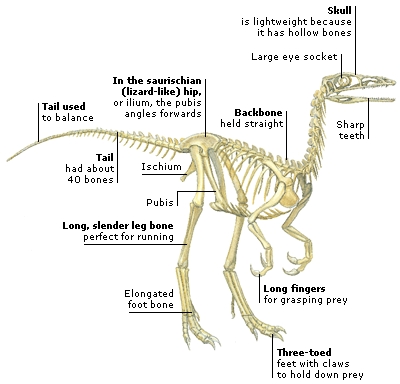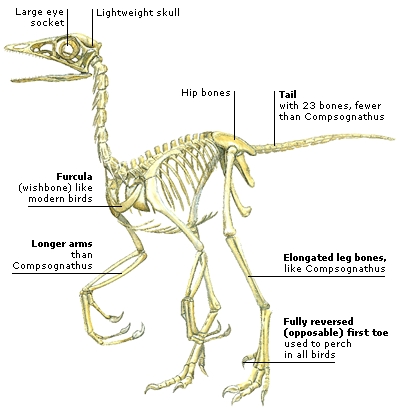DK Science: The Bird Connection
There are dinosaurs flying in our skies today – despite more than a century of arguments, most scientists now believe that small meat-eating dinosaurs evolved into birds. The development of feathers turned dinosaurs that could run or climb into birds that could fly. The earliest true bird is Archaeopteryx, which lived during the late Jurassic in the area known today as southern Germany. A small hunting dinosaur called Compsognathus also lived in that area at that time. Archaeopteryx looked like a cross between a reptile and a bird, and it had strong legs and feathers that it would have used to fly. Compsognathus was bird-like, with long back legs and hollow bones.
Bony tail core
Ankle joint
Long legs
Short body
Enlarged breast bone
Teeth in long, slim jaws
Slim, flexible neck
Long, clawed fingers
Compsognathus (“pretty jaw”) looked like a tiny version of the huge meat-eaters that lived during the late Jurassic. Yet, despite its sharp claws and teeth, it was only the size of a chicken. It was an agile hunter, chasing small animals that included insects and fast-moving lizards. It ran swiftly along on its two back legs, its long tail balancing it as it made fast turns in pursuit of its prey.
Compsognathus was one of the first dinosaurs discovered. The first skeleton was unearthed in 1859. It had long jaws, sharp teeth, a small body, strong hind legs with three-toed feet, and a heavy tail. Its long hind legs were built for running, and the claws and teeth show it to have been a hunter. It looks just like the skeleton of any other meat-eating dinosaur.
Archaeopteryx had wings, with flying feathers arranged just like those of a modern bird, and its body was covered in feathers. However, it had the head, clawed hands, and long, bony tail of a dinosaur. It lived on tropical desert islands and walked and fluttered after its flying insect prey. It could not have flown very far or very fast as it did not have strong flight muscles.
The skeleton of Archaeopteryx closely resembles that of Compsognathus. Only a few examples of Archaeopteryx skeletons have been found, and one of these was only identified in 1987 – although it had been in a German museum for many decades, palaeontologists had thought it was a Compsognathus. The presence of a wishbone and the length of the arms are the main differences between these two animals.
To the modern eye, birds do not look like dinosaurs, despite their ancestry. The skeletons of birds have evolved over time, becoming much more lightweight than that of either Compsognathus or Archaeopteryx. This means that the modern bird needs to use much less energy to stay airborne. The heron is the modern bird whose shape perhaps most resembles Compsognathus and Archaeopteryx.
A typical modern bird has lost some features that were common to Compsognathus and Archaeopteryx. It does not have hand claws, toothed jaws, or a bony tail because they would not help it to fly. Instead, the hand only supports the wing feathers, a lightweight horny beak has replaced the teeth, and the tail is a muscular stump controlling a broad surface of feathers.
To order this book direct from the publisher, visit DK's website.


